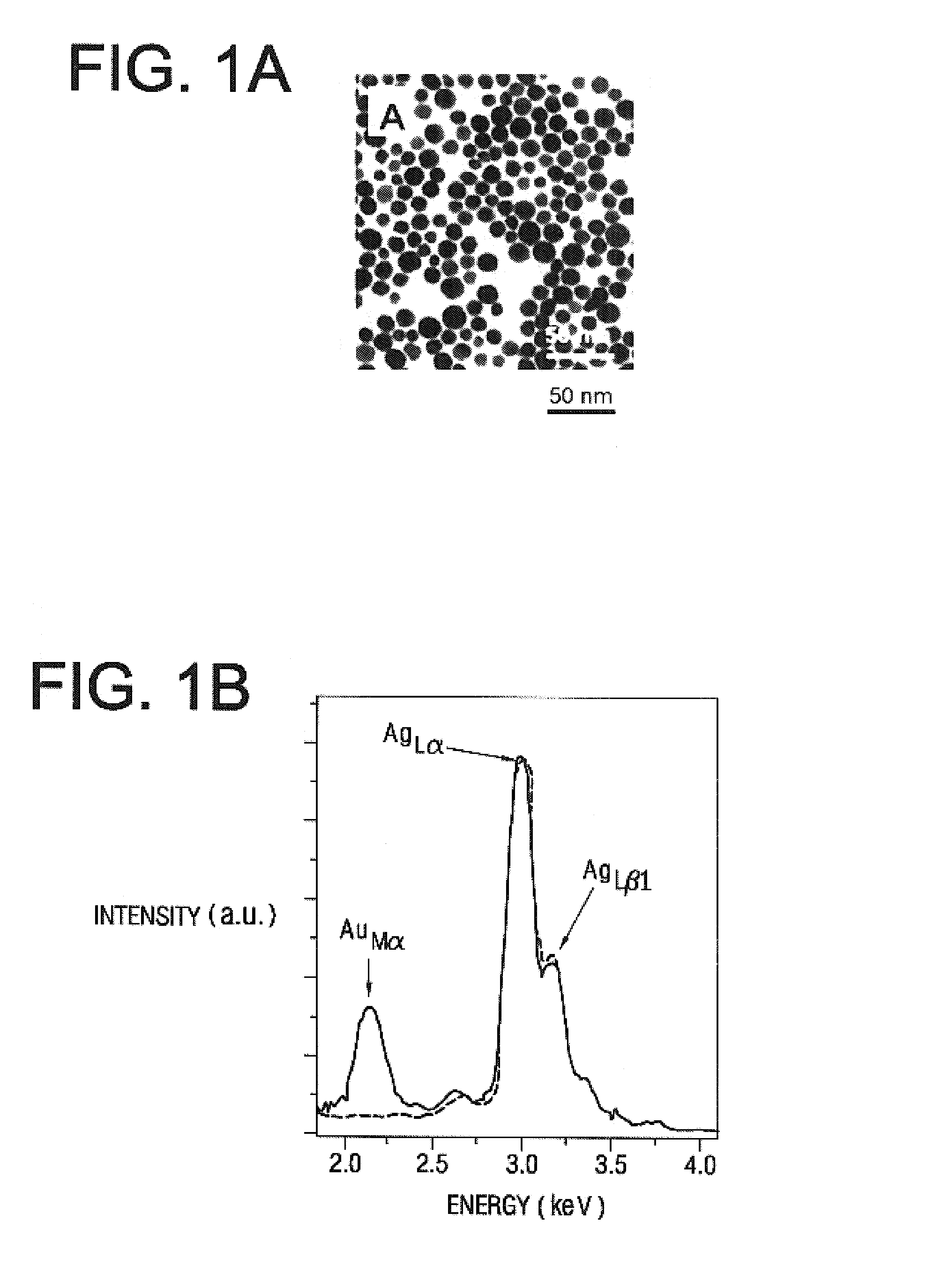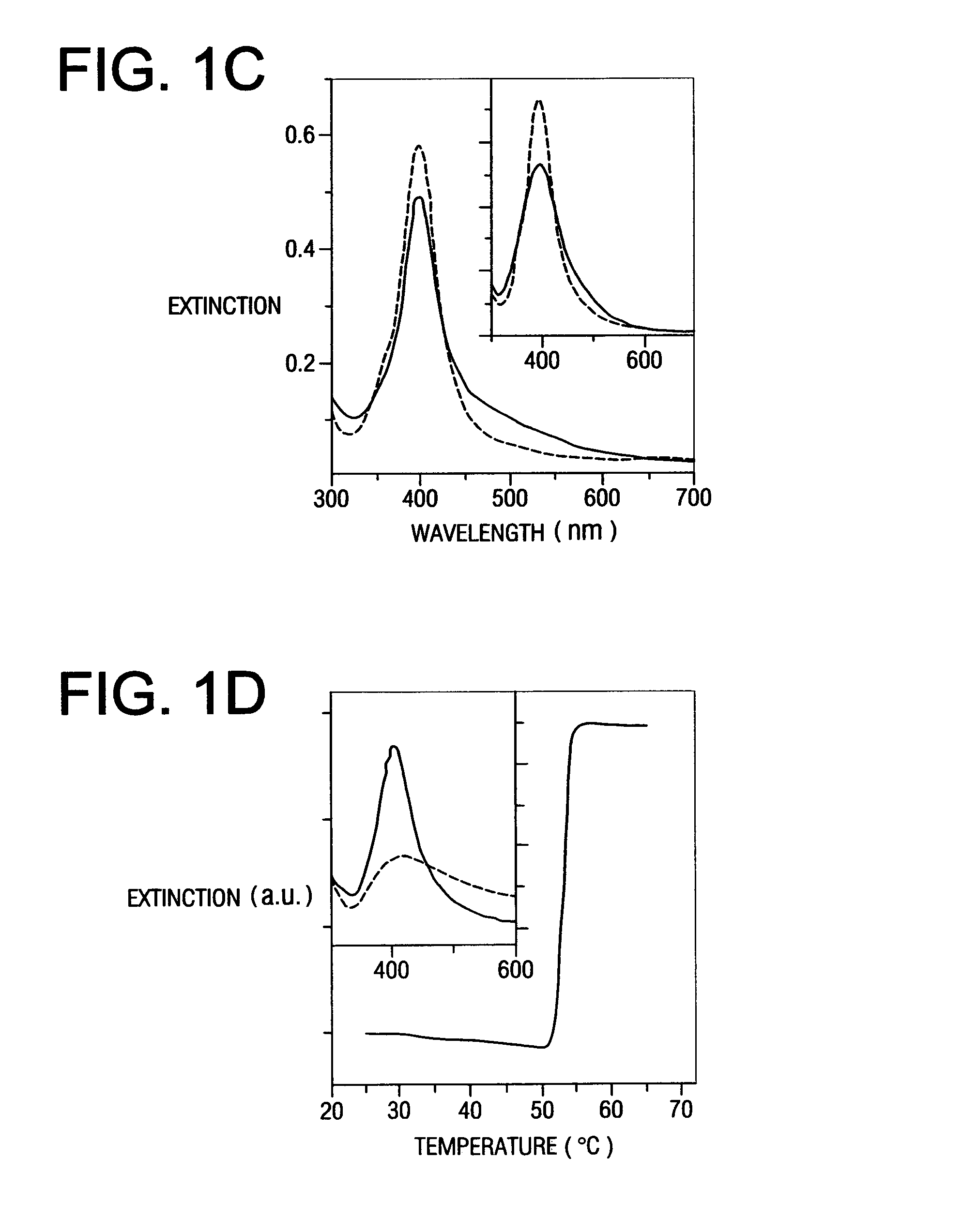Non-alloying core shell nanoparticles
a core shell and nanoparticle technology, applied in the direction of magnetic materials, powder delivery, iron oxide/hydroxides, etc., can solve the problems of difficult modification of cdse and cds quantum dots, difficult to achieve stable oligonucleotide conjugates, and limited success of extensive use of approaches
- Summary
- Abstract
- Description
- Claims
- Application Information
AI Technical Summary
Benefits of technology
Problems solved by technology
Method used
Image
Examples
example 1
Synthesis of Ag / gold Core / shell Nanoparticles Prepared Via a Two-step Synthesis
[0038]This Example illustrates the inventive process for preparing Ag / gold core / shell nanoparticles. In part A, methods for preparing silver cores are described. In part B, a method for preparing Ag / gold core / shell nanoparticles is provided. Silver nanoparticles are desired compositions for building blocks in material synthesis and as biological labels for two important reasons: (1) silver particles exhibit a surface plasmon band between ˜390 and 420 nm, depending on the particle size;11 this is a spectral regime that is distinct from that of gold (520–580 nm). (2) The extinction coefficient of the surface plasmon band for an silver particle is approximately 4 times as large as that for an gold particle of the same size.12 Therefore, silver particles functionalized with DNA would provide not only an opportunity to tailor the optical properties of DNA / nanoparticle composite structures but also routes to ne...
example 2
Preparation of Silver / gold Core / shell Nanoparticle-oligonucleotide Conjugates
[0059]This Example describes the preparation of silver / gold core / shell nanoparticle oligonucleotide conjugates as probes for detecting a target nucleic acid. Two methods were employed and the resulting probes were then compared for stability. The oligonucleotide sequences used in making the conjugates are shown in FIG. 2a. These sequences were synthesized using standard phosphoramidite chemistry according to the literature. (James J. Storhoff, Robert Elghanian, Robert C. Mucic, Chad A. Mirkin, and Robert L. Letsinger, J. Am. Chem. Soc., 1998, 120, 1959).
[0060](a) Preparation of Core / shell Nanoparticle Conjugates
[0061]Method No. 1: Nanoparticle probes with appropriate probe oligonucleotides were prepared by derivatizing 10 mL of aqueous core / shell nanoparticle colloid (from method no. 1) with 8˜10 OD (in about 500 uL) of alkanethiol-oligonucleotide (final oligonucleotide concentration is about 2 μM). After s...
example 3
Comparison of Silver, Silver / gold Core / shell and Silver / gold Alloy Nanoparticle Oligonucleotide Conjugates
[0071]In this Example, the silver / gold core / shell nanoparticles prepared as described in Example 1 (method no. 1) were compared to gold nanoparticles2 and silver / gold alloy nanoparticles prepared by literature methods. See Link, S.; Wang, Z. L.; El-Sayed, M. A. J. Phys. Chem.B 1999, 103, 3529. Following literature procedure, 0.8 mg of HAuCl4.3H2O and 1.8 mg of AgNO3 were dissolved in 95 ml of nanopure water. The solution was heated to reflux, and 5 ml of 1% sodium citrate was added to the solution. After refluxing an additional 30 min., the solution was allowed to cool to room temperature. The UV-Vis spectrum of the alloy particles exhibits a surface plasmon band at 428 nm with a full width at half-maximum (FWHM) of 90 nm (0.62 eV). In contrast, the UV-Vis spectrum of the silver / gold core / shell nanoparticle, with a comparable silver / gold ratio, exhibits a surface plasmon band at...
PUM
| Property | Measurement | Unit |
|---|---|---|
| diameter | aaaaa | aaaaa |
| Tm | aaaaa | aaaaa |
| temperature | aaaaa | aaaaa |
Abstract
Description
Claims
Application Information
 Login to View More
Login to View More - R&D
- Intellectual Property
- Life Sciences
- Materials
- Tech Scout
- Unparalleled Data Quality
- Higher Quality Content
- 60% Fewer Hallucinations
Browse by: Latest US Patents, China's latest patents, Technical Efficacy Thesaurus, Application Domain, Technology Topic, Popular Technical Reports.
© 2025 PatSnap. All rights reserved.Legal|Privacy policy|Modern Slavery Act Transparency Statement|Sitemap|About US| Contact US: help@patsnap.com



